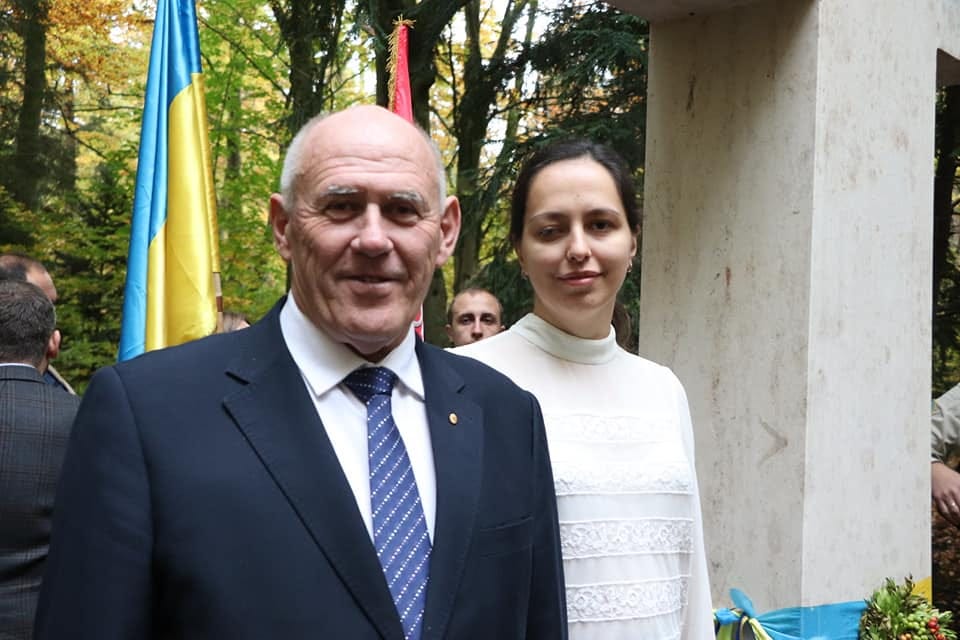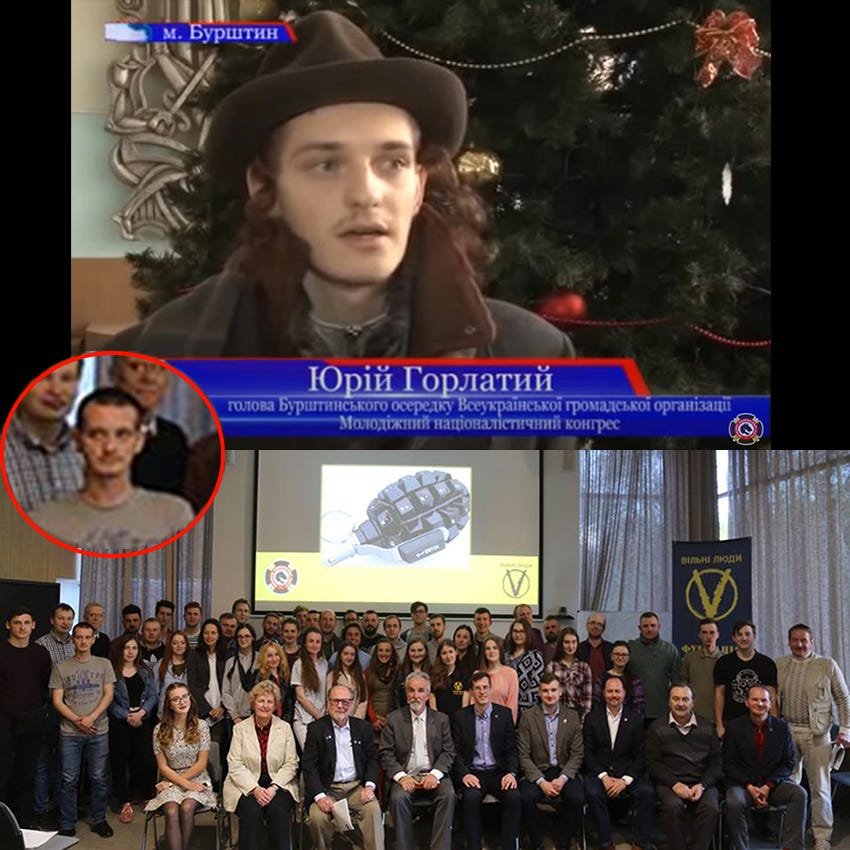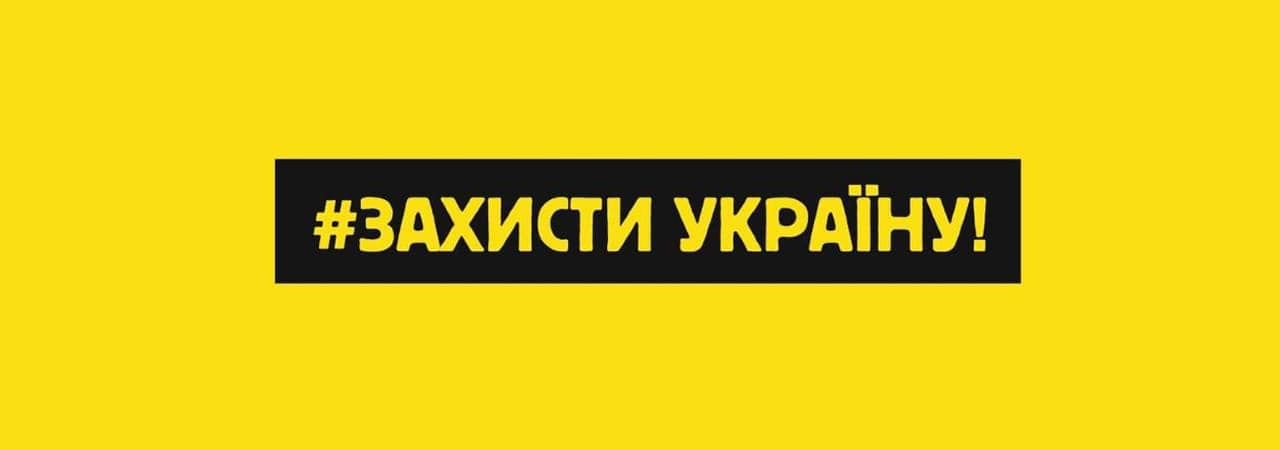Youth Nationalist Congress (MNK) "Rebel Vertep" cast, Stepan Bandera monument, Lviv, 2018. Kneeling front and center are the Jewish characters. The armed "insurgents" standing on either side are MNK leaders: left, Vasyl Pankevych, organizational officer; right, Mykola Mysak, deputy chairman.In late December 2018, in anticipation of the 110th birthday of the Ukrainian fascist Stepan Bandera (1909-1959), the Organization of Ukrainian Nationalists-Bandera (OUN-B), which collaborated with Nazi Germany, published a propaganda video that stated, “there is no reason to identify [Bandera’s] name with various forms of hatred.” Sometimes it seems as if “respectable” contemporary Banderites really believe their brazen lies, that not only did their hero oppose the Nazis, but “Bandera’s revolutionary struggle was aimed at creating a democratic Ukraine.” They likewise often insist that the OUN-B’s Ukrainian Insurgent Army (UPA) didn’t massacre Jews, but saved them.
So how does one reconcile such a deliberately whitewashed version of history with the anti-Semitic “Rebel Vertep,” or UPA-themed Christmas play, annually performed by the Youth Nationalist Congress (MNK)—the OUN-B’s militant youth group in Ukraine—in which Jews are referred to as “kikes” and implicitly identified as enemies of the nation who got what they had coming to them in World War 2?
To be sure, the play is not entirely original; it is a Banderite appropriation of an anti-Semitic Ukrainian tradition re-enacting the birth of Jesus that is hundreds of years old. Thus, King Herod becomes Stalin, the devil represents the NKVD, the shepherds are replaced by armed Ukrainian Nationalists, and the “cunning Jew” is a Jewish-Bolshevik agent donning fake payot. At least once, in 2011, the Jew was Lazar Kaganovich, a central organizer of the catastrophic forced collectivization of Soviet Ukraine in the early 1930s which resulted in a terrible famine that many Ukrainian nationalists insist was a genocide worse than the Holocaust.
Solomiya Farion, today the head of the MNK, a dozen years ago co-authored the “Rebel Vertep” script, according to which the principal Jewish character is named Moshko (Moses). “Moshko” makes his entrance after a song about the liberation of Ukraine. “So, you sing without us this time?” he complains, and asks his wife, “Can you hear, Sarah, they’re singing? And they stay away from Moshko’s tavern.” The peasants have gone crazy, she tells him, because despite all their troubles, “they keep Ukraine in their head.” He questions why they need a country when they can eat and drink at his tavern. “Stop fooling us, Moshko!” a Ukrainian Nationalist warns him. “We are also humans — we want to live. We want to fight for Ukraine, to glorify the Son of God.”
MNK "Rebel Vertep" cast, 2013. Solomiya Farion, then-deputy chairman of MNK, is wearing a turtleneck sweater, sitting behind the "insurgent" pointing his weapon at "Moshko."Moshko has been put on notice, but laughs defiantly. “What is the Messiah for the [Ukrainian] peasant?” he wonders, dehumanizing Ukrainians, whose existence he evidently only considers worthy to stuff his pockets. “Peasant should plow, peasant should sow! Peasant should learn to thresh grain and bring everything to the Jew.” Sarah agrees, because otherwise, “what will we, Moshko, live on?”
“Get out of here, Moshko, because there will be no bargaining, and all the honest people stay away from your tavern,” one of the armed Ukrainian Nationalists declares. Another pushes Moshko to the ground with his submachine gun, yelling, “We will build Ukraine from the San to the Don [rivers]. We will not let anyone [who isn’t Ukrainian] rule over the people!” Moshko grows increasingly indignant, rants about the invincibility of “the Jew,” and then proclaims, “I’m going to bring Herod”—Stalin, that is—to crush this rebellion against Jewish-Bolshevik rule over Ukraine.
When “Herod” enters, Moshko and Sarah throw themselves at his feet. “The noblest, holy king, they insult your faithful servant [‘the Jew’], and they despise you. They glorify Ukraine!” In the end, the Nationalists overthrow Stalin and free Ukraine, presumably cleansing it of parasitic Jews—a Christmas miracle. As an information and propaganda officer of the MNK once summarized the plot of the play, “good (i.e. Ukraine) defeats evil (Soviet occupation).” There is no doubt which side Ukrainian Jews are identified with, not as Ukrainians but foreign occupiers. This past January, the MNK brought the anti-Semitic “Rebel Vertep,” or “Insurgent Nativity Scene,” to eastern Ukraine for the purpose of entertaining front-line soldiers.
In recent years, these annual performances around the country have served to fundraise for the MNK’s “Free People” (Vilni Liudy, VL), an NGO and sort of Banderite proto-party that last year spearheaded the launch of the rightist “Movement to Resist Capitulation” (Rukh Oporu Kapitulyatsiyi, ROK). Largely an MNK creation, the ROK has been erroneously described as a “democratic movement” by the Atlantic Council’s “UkraineAlert,” which can be explained in part by the AC’s own ties to the Banderites. The MNK, VL, and ROK tellingly all have an office in the OUN-B’s headquarters building in Kyiv, the Stepan Bandera Center for National Revival.
"Rebel Vertep" performance, 2019. The briefcase bears the stickers of "Free People" (VL, left) and the Youth Nationalist Congress (MNK, right).The Youth Nationalist Congress was founded in 2001 on the initiative of the OUN-B at a time when its 1990s apparatus in post-Soviet Ukraine was falling apart. Before the MNK, there was the Youth Congress of Ukrainian Nationalists (MKUN), the youth wing of the OUN-B’s far-right political party, the Congress of Ukrainian Nationalists (KUN). The party also had a paramilitary wing, the ultranationalist Stepan Bandera All-Ukrainian Organization “Trident,” the driving force behind the creation of the notoriously radical Right Sector in late 2013. Like the Svoboda party, Right Sector considers itself a Nationalist organization carrying on the work of Stepan Bandera, but it contains significant neo-Nazi elements.
The KUN-led alliance of Banderite groups began to crumble in the late 1990s, and the OUN-B’s creation of the MNK as an independent organization perhaps sealed this fracture. In the early 2000s, “Trident” was viciously opposed to the KUN and the new Banderite youth group, and apparently still hasn’t reconciled with the international OUN-B leadership, likely because of the latter’s professed liberalism and its reluctance to openly embrace far-right radicalism in the 21st century.
When a German journalist was invited to observe an MNK summer camp in 2015, he met Solomiya Farion, whom he described as the organization’s “unofficial resident ideologist.” She co-authored the “Rebel Vertep” script in 2008 as a co-founder and propaganda chief of the Lviv branch of the MNK. The militant Youth Nationalist Congress, the journalist was told,
wants to have nothing to do with parties like Svoboda and claims to be also different from groups “of bald rowdies in army boots, who beat up foreigners.” With such groups, for example Prawyj Sektor [Right Sector], they cooperate “only as little as necessary in the fight against Russia,” and try to stay away if possible. They promote a kind of “positive” nationalism – whatever this may be.
Stefan Romaniw, Ukrainian Australian international leader of the OUN-B, with Solomiya Farion, chairman of the MNK, at the Banderite pilgramage to Stepan Bandera's grave in Munich to mark the 60th anniversary of his assassination, October 2019.In 2017, an MNK summer camp hosted a state-supported event featuring two neo-Nazi band leaders, which earned the OUN-B’s official youth group in Ukraine a mention in Zaborona’s recent exposé of the propagandistic “fact-checker” StopFake’s ties to neo-Nazis, because StopFake’s Marko Suprun (alleged to be an OUN-B operative) spoke there as well. Solomiya Farion, by then the chairman of MNK, also spoke, as well as Yuri Mykytyn, who called in from the United States as the head of the OUN-B affiliated Ukrainian American Youth Association (UAYA).
The UAYA has a decades-old tradition of holding Banderite “political-ideological” workshops in the last week of December at its camp in Ellenville, New York, where one can find what is apparently the world’s oldest monument built in memory of Stepan Bandera. In recent years (2016-19), MNK and VL members have regularly served as ideological instructors at these winter camps and sometimes keynote speakers at the UAYA’s annual “Holiday of the Heroes” summer event which honors the OUN-B and UPA. A representative of the anti-Semitic MNK first visited the UAYA camp in Ellenville no later than December 2012, to participate in an “ideological seminar.”
The MNK-VL apparatus is evidently the OUN-B’s chief vehicle to organize in Ukraine and agitate for another “Maidan” revolution. In the past several years, the Banderite diaspora network has boosted the MNK and VL and hosted its representatives in Washington and Ottawa.
The OUN-B affiliated League of Ukrainian Canadians (LUC), which wields significant influence in the Ukrainian Canadian Congress (UCC), the Toronto-based Buduchnist Credit Union (BCU) Financial Group, and the Conservative Party of Canada, has been one of the VL’s chief fundraisers via its BCU-sponsored “Friends of Ukraine Defense Forces Fund.” On the homepage of its website, the LUC promotes the “Movement to Resist Capitulation” (ROK), which it has lobbied the UCC to support. The Center for US-Ukrainian Relations, allegedly led by the US leader of the OUN-B, has helped hook up Andriy Levus, who is an MNK member, the head of VL, and seemingly the de-facto leader of the ROK, with prominent hawks in Washington, such as the longtime president of the hardline American Foreign Policy Council.
A chill went down my spine when I saw Yura Horlatiy—an MNK member who played the role of “Moshko” in 2015 while he was the chairman of the organization’s branch in Burshytn, western Ukraine—tagged in a Facebook photo taken at an MNK-VL event held three years later in Lviv, because the alleged US and Canadian leaders of the OUN-B are sitting in the front row.
"Free People Course," Lviv, April 2018. Yura Horlatiy is pictured above as "Moshko" and below standing on the left, highlighted in the red circle. Sitting second to the left is Oksana Prociuk, CEO of BCU Financial Group. To her right is Borys Potapenko, president of the OUN-B's "International Council in Support of Ukraine," and Walter Zaryckyj, executive director of the Center for US-Ukrainian Relations.Standing behind Horlatiy on the left is Ivan Kishka, a coordinator of VL who at the time had recently been replaced as the MNK chairman, and to the right is Orest Steciw, the former president of the LUC. Steciw’s successor, Roman Medyk, is seen sitting on the far-right, who is also the chairman of the BCU Foundation. Two to the left of him is Ihor Kozak, the first vice chairman of BCU Financial and the external affairs director of the LUC. Standing three to the right of Horlatiy is Kishka’s deputy-turned-successor Solomiya Farion.
Several other prominent members of the Youth Nationalist Congress and “Free People” as well as the Banderite diaspora network can be seen in the photo, including Borys Potapenko, the Ukrainian American president of the so-called “International Council in Support of Ukraine” (ICSU), which serves as the global coordinating body of NGOs affiliated with the OUN-B. “Free People” officially became a member organization of the ICSU some six months later.
Also pictured in the above group photo is Mykola Mysak, deputy chairman of the MNK, and Vasyl Pankevych, its organizational officer, both of whom had a part earlier that year in the “Rebel Vertep” as armed Nationalists. Presumably, one of them pushed “Moshko” to the ground with his weapon as he yelled, “We will build Ukraine!” They were both co-founders of the “Protect Ukraine” initiative, launched by the Ternopil branch of “Free People” in the spring of 2019. In the months to come, “Protect Ukraine” morphed into the “Movement to Resist Capitulation” (ROK).
MNK-VL members in Ternopil announced the creation of “Protect Ukraine” on April 5, almost a week after the first round of the 2019 Ukrainian presidential elections, in which Petro Poroshenko, the incumbent candidate, received just 16% of the vote. Ukrainians cast almost twice as many ballots (30%) for Volodymyr Zelenskiy, a comedian with no political experience who campaigned on bringing peace to eastern Ukraine. Many Ukrainian nationalist organizations coalesced around the MNK-VL’s “Protect Ukraine” initiative before the second round of the presidential election.
On April 11, the Banderites presumably convened the meeting that made “Protect Ukraine” a national campaign. Several far-right leaders signed on, including but not limited to Yuriy Shukhevych, the elderly son of Roman Shukhevych (1907-50), the UPA supreme commander and wartime OUN-B leader in Ukraine; Dmitry Yarosh, the founder of Right Sector; Andriy Tarasenko, the current head of Right Sector; Bohdan Chervak, the leader of the OUN-M, which was once the chief rival of the Banderites; and Stepan Bratsiun, the chairman of the KUN. (Yarosh and Tarasenko both formerly commanded “Trident.”)
Free People leader Andriy Levus seems to have chaired the meeting. Also present was Stefan Romaniw, the international OUN-B chairman, and it looks like Walter Zaryckyj was there too—the executive director of the Center for US-Ukrainian Relations and allegedly the US leader of the OUN-B. Three days later, Andriy Parubiy, the white nationalist chairman of Ukraine’s parliament (2016-19), who co-founded the 1990s neo-Nazi “Social National Party of Ukraine,” publicly threw his weight behind “Protect Ukraine.”
National launch of "Protect Ukraine," April 11, 2019. Circled on the left appears to be Walter Zaryckyj. To his right is Stepan Bratsiun, KUN; Stefan Romaniw, OUN-B; Bohdan Chervak, OUN-M; Yuriy Shukhevych; and Andriy Levus."#Protect Ukraine!" Image posted by Andriy Parubiy on Twitter and Facebook, April 14, 2019.The MNK, VL, and “Protect Ukraine” led a march in Kyiv on April 19, the day of Poroshenko’s debate with Zelenskiy. Two days later, the latter received an unprecedented 73% of the vote, whereas Poroshenko didn’t do much better than the first round (24.5%). Rounding up, Poroshenko voters declared themselves “the 25%,” a fitting name for the nationalists’ budding anti-democratic movement against Zelenskiy. Ahead of that summer’s parliamentary elections, while much of the far-right united in a Svoboda-led electoral alliance, “Free People” supported Poroshenko’s rightist “European Solidarity” party, which won just 25 seats of 450 total. Parubiy was the #2 candidate on Poroshenko’s party list, and Levus was #29.
Later that summer, the MNK played a leading role in the creation of the National Ukrainian Youth Organization (NUMO), and Solomiya Farion subsequently became a board member. She was one of three MNK representatives at the founding meeting of the NUMO on August 5. Another was Serhiy Repik, the head of the MNK’s secretariat. Elana Podobed-Frankivsk, the executive director of this new coalition of “patriotic” youth organizations, might not be an anti-Semite, but she sure is married to one.
Three days later, the Bellingcat Monitoring Project published an article (“How to Mainstream Neo-Nazis”) about an organization called the Education Assembly tied to the violent, neo-Nazi “C14,” the name of which is widely believed to be a reference to the white supremacist “14 words.” Repik and another attendee of the August 5 meeting, Dmytro Kurylenko, at that time had expressed interest on Facebook in attending an upcoming Education Assembly event. Kurylenko also joined NUMO’s board of directors, on behalf of the National Alliance, which was founded in 2005 as an MNK splinter group and organizes an annual “Banderstadt” music festival.
The “Movement to Resist Capitulation” was finally launched in early October. A “Strategic Council” was formed mostly of former diplomats and other prominent people, many of them respected in the West, including Josef Zissels, perhaps the most important Jewish ally of Ukrainian nationalists. It is because of this advisory council that the rightist ROK is able to get away with describing itself as a “broad-based … far-reaching coalition.” The far-right appears to play a more commanding role in the ROK’s “Coordination Council.” Among its members are Andriy Levus, one of several “Free People” (i.e. MNK) representatives; Ihor Mazur, a leader of the UNA-UNSO, one of the principal organizations that formed Right Sector; Serhiy Kvit, a former “Trident” captain and Education Minister of Ukraine (2014-16); and Ihor Lapin, a former company commander of the far-right affiliated Aidar Battalion, which Amnesty International accused of war crimes.
The neo-Nazi Azov movement is not formally part of the ROK, but it has been a central force in the broader anti-Zelenskiy movement tacitly supported by Poroshenko. Azov is most closely associated with the slogan, “No to Capitulation!” As documented by journalist Oleksiy Kuzmenko, the month of the ROK’s launch and days before a major “No to Capitulation!” protest, Poroshenko’s TV channel gave air time to a press conference “dominated” by Azov’s political party, the National Corps. More recently, Andriy Levus spoke at a “March of Patriots” alongside neo-Nazi leaders Andriy Biletsky (National Corps) and Yevhen Karas (C14). Several weeks later, far-right leaders from the National Corps, Svoboda, and “Democratic Axe” joined an ROK press briefing.
As I have said before, sworn members of the crypto-fascist OUN-B, which professes respect for democratic principles and human rights but time and again shows its true colors, are not neo-Nazis but neo-Nazi sympathizers, collaborators, and enablers—somewhat akin to the role played by the OUN-B when Nazis took over Ukraine during World War 2. The same applies to the Bandera Youth of the MNK, but they are skating closer to the edge.
MNK "Rebel Vertep" actors pose with what appears to be a couple of Ukrainian nationalists in costume presumably as a Klansman and an African American, 2018. "Moshko" is second to the right.








